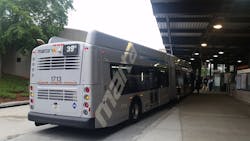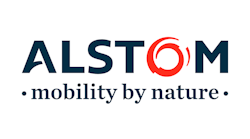In one of the most congested cities, a fire that caused an Interstate bridge collapse forced closure of all five lanes in each direction. The Interstate 85 bridge collapse in Atlanta on a Thursday evening in March of this year was stated as “… as serious a transportation crisis we could have,” by Atlanta Mayor Kasim Reed in a news interview that evening. More than 220,000 cars are estimated to drive over that bridge per day.
Metropolitan Atlanta Rapid Transit Authority employees mobilized to get additional capacity and service out there that evening.
Chief Operating Officer Richard Krisak was at home watching the bridge collapse on TV. He said MARTA staff quickly mobilized, used a lot of re-deployed staff and office staff that volunteered to work in rail stations.
“The thing that really impressed me the most was how quickly we could tailor and adjust the service to meet the demand,” he said. “We were constantly monitoring during the event because putting a lot of extra service out there costs a lot of extra money for us.”
They closely monitored the ridership using the Breeze technology to look at fare gate exits and entries and parking lot usage, he explained. As they moved through the event they could fine tune to meet the demand with the right amount of service. By the time they got to the last week or two they were back to running normal service with very little enhancement.
MARTA General Manager and Chief Executive Officer Keith Parker said that evening on camera there was Governor Nathan Deal, Mayor Kasim Reed and Georgia Department of Transportation Commissioner Russell McMurray telling people to “Ride MARTA.”
“That would not have happened three years ago,” Parker said. “You would not have had the three most prominent folks in transportation in the state making those announcements.”
Turning the Tide
Parker described the adversarial relationship MARTA had with stakeholders when he came onboard. “Many elected officials viewed MARTA as a pariah; you don’t want to support it, you stay away from it, you beat up on it. That’s the way you win votes,” he said.
With MARTOC, the Metropolitan Atlanta Rapid Transit Overview Committee, Parker said there was no trust. When asking for documents of various things, he described it as doing it nearly by subpoena instead of simply asking for a copy of a report. “It was very adversarial,” he stressed.
While finishing his final 90 days in San Antonio, Parker would come to Atlanta several times a month and would hold meetings with different stakeholder groups, holding roundtables with corporate CEOs, neighborhood leaders, civil rights leaders and small business owners. “I would ask three basic questions,” Parker said. “First, what do you think of MARTA now, secondly, what would you like MARTA to become and thirdly, what are you willing to do to help?
“I wanted to build a sense of collaboration with the different parties. … they had a stake in me being successful. Me being successful meant the agency being successful, means they get something, too.”
The other goal, Parker said, was to disarm the elected officials. MARTA was in dire financial straits, he was sure they were expecting him to walk in asking for more financial support.
“Instead, I remember my first meeting with the governor … and the first surprise was that I walked in the room alone,” he said. “I went in and of course he had his staff around.
“I said, ‘Governor, I promise you this is going to be the quickest and easiest meeting you’re going to have all day. I came in to introduce myself and to tell you, we’re not asking for anything. Give me a year to get our house in order and to prove ourselves, that we’re a company worth of investment and if we do that, then we might be coming back.’”
As he was walking out the door, Parker said he added one more thing. “’There’s some legislation being discussed that’s been introduced that would significantly reduce my ability to run the agency as I see fit; I think an undue amount of regulation. I would like your support in holding it off.’
“He offered support to that and eventually that legislation died.”
At the time, MARTA was facing a projected $33 billion budget deficit and not getting better. Employees hadn’t had raises, there were forced furloughs, major increases in healthcare, morale wasn’t particularly high. There was also a very adversarial relationship with the media. It was a difficult and challenging environment.
Turning Things Around
The objective was to get some early wins to send a message they were serious about looking for all ways to save. They scoured the budget, the expense column in particular, and looked for where money could be saved.
They switched from a paper pay stub every two weeks for nearly 5,000 employees to an automated system to save a few hundred thousand dollars a year. They made some adjustments in a number of the ways capital money is spent to free up dollars in positions. They had a freeze on new hires for extended period except in two areas, an office of transit-oriented development and the external relations and communications groups.
As a result of the big and small cuts, they saw the year-to-year costs stay flat. “We didn’t go up even one percent,” said Parker. “We were able to add service, pay our people more and keep fares at the same level and balance the budget … and had a $9 million surplus.”
There’s a general acceptance of transit as a player in economic development in the Atlanta region and when you look at the highest growth areas in the region, the hottest properties are around transit stations.
“When you look at where people want to live,” Parker said, “ … they want to live in densely populated places where they can get around without a car, that they can have a good vibrant lifestyle, walking a neighborhood grocery store, being able to get to the park riding their bikes and not being totally beholden to terrible traffic all the time.”
Another sign of acceptance is when on November 8, 2016, the half-penny sales tax was approved with nearly 72 percent approval, the highest approval rating in the country. “The citizens of Atlanta with a 72 percent vote saying we want to tax ourselves more to have more MARTA. We’ve seen a sea change,” stated Parker. “MARTA had not passed a single initiative of any kind in 40 years.
“I think those are strong affirmations that we’re moving in the right direction.”
Host to the Industry
With the American Public Transportation Association’s triennial Expo in Atlanta in October, MARTA is ready to host and showcase the many things they’ve done and have planned for the future.
And in the coming weeks and months we’ll have more on much of it. There will be details on the regional expansion program, extending the red line north, the blue line east and commuter rail to the newest MARTA county, Clayton County; information on ways they have improved efficiencies of their bus and rail fleet, details on how they’ve developed their transit asset management plans, a new mobile payment launch, the airport connector, how they keep the system safe, providing soccer at the station and their fresh markets bringing fresh produce to food deserts in Atlanta.
Parker said, “They’re going to see a downtown that’s very vibrant and growing and we’re a part of that vibrancy and then we’re going to show them a really nice time with some new technologies that we’ll be exploring.
“I want them to learn from us and us from them.”






